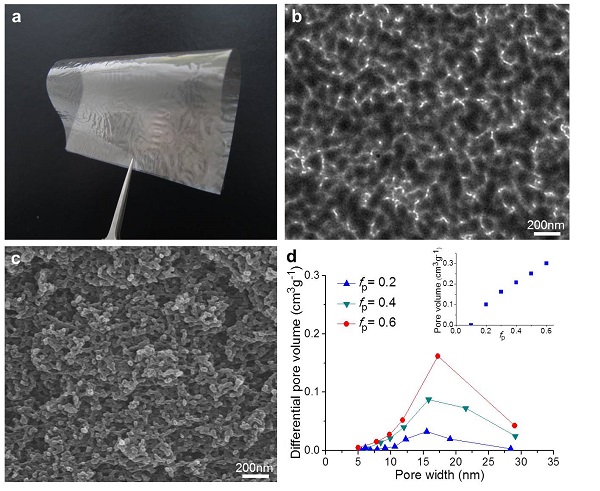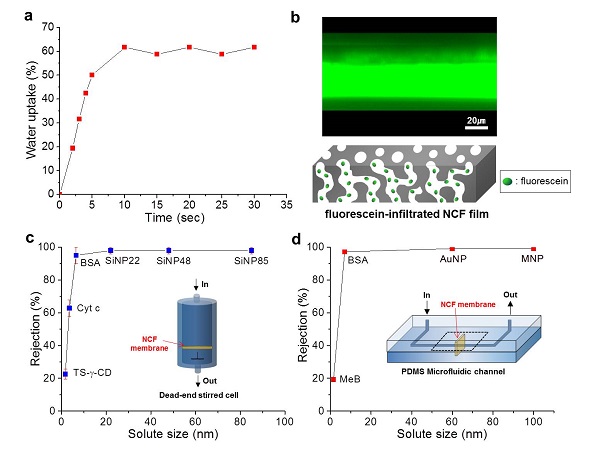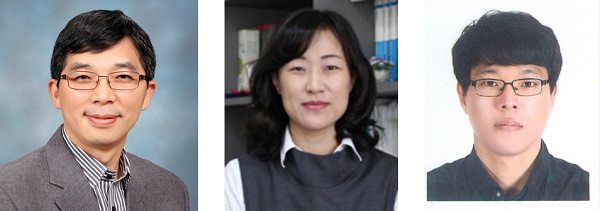Media Center
A multimedia mosaic of moments at GIST
GIST Excellence
[Press release] GIST Professor Ji-Woong Park leads research team to develop a bicontinuous nanoporous structure to increase the longevity of enzymes
- 엘리스 리
- REG_DATE : 2016.08.23
- HIT : 973
GIST Professor Ji-Woong Park leads research team to develop a
bicontinuous nanoporous structure to increase the longevity of enzymes

The structure of a bicontinuous NCF film. a) Optical photograph of an 8×12 cm2 NCF film (fp=0.6) with a thickness of 40 μm. b) TEM image of an ultrathin cross-section. The brighter regions correspond to the pores through the film. c) SEM image of an NCF film fractured after being immersed in liquid nitrogen. d) BJH pore size distributions of NCFs prepared with fp=0.2, 0.4, and 0.6, respectively. Inset: pore volume of the NCF as a function of fp.
Enzymes are biological molecules that act as catalysts for chemical reactions necessary for life. By enclosing an enzyme and its substrate within a three-dimensional structure or cage, the enzyme"s catalytic efficiency improves dramatically because they are protected from environmental factors, such as the presence of proteases, which can cause degradation. Placing the enzyme and its substrate within a suitable enclosure enables the desired enzymatic reaction to continue without being hampered by competing reactions or by diffusion kinetics.
However, by enclosing an enzyme and its substrate within a three-dimensional structure, the issue becomes one of how to create a simple and efficient structure that easily allows for the movement of reactants and products through the structure. To address this problem, Professor Ji-Woong Park from the School of Materials Science and Engineering at the Gwangju Institute of Science and Technology (GIST) has led a team of researchers to develop a bicontinuous nanoporous structure to increase the longevity of enzymes. Their novel approach demonstrated the feasibility of facile in vitro utilization of biocatalysts by running a biocatalytic reaction that could be recycled many times with nearly no loss of catalytic activity.

Transport of water and solutes through NCF films. a) The weight of the water taken up by an initially dry NCF film (fp=0.6) as a percent of the weight of the dry film. b) A confocal microscope tomographic image of the fluorescein-infiltrated NCF film with fp=0.6. c) and d) Filtration of different solutes dissolved in aqueous solutions by the NCF (fp=0.6) film using (c) a dead-end stirred cell and (d) an integrated microfluidic device. The solute rejection (%) was plotted as a function of average solute size: MeB, 1.5 nm; Ts-γ-CD, 1.7 nm; cytochrome c, 3.5 nm; BSA, 6 nm; SiNP22, 22 nm; SiNP48, 48 nm; SiNP85, 85 nm; AuNP, 60 nm; MNP, 100 nm.
Their paper entitled "Bicontinuous Nanoporous Frameworks: Caged Longevity for Enzymes" was authored by Jae-Sung Bae, Eunkyung Jeon, Su-Young Moon, Wangsuk Oh, Sun-Young Han, Jeong Hun Lee, Sung Yun Yang, Dong-Myung Kim, and Ji-Woong Park and published by Angewandte Chemie on August 11, 2016.

(From left to right): Professor Ji-Woong Park, Professor Sung Yun Yang, and Dr. Jae-Sung Bae
According to Professor Ji-Woong Park, "This research will help develop proprietary technology that will offer greater industrial uses of enzymes by allowing easier and more efficient control within an artificial environment. By regulating enzymatic reactions through our bicontinuous nanoporous structure, our approach can be used to develop new applications for drug administration or even new environmental sensors."